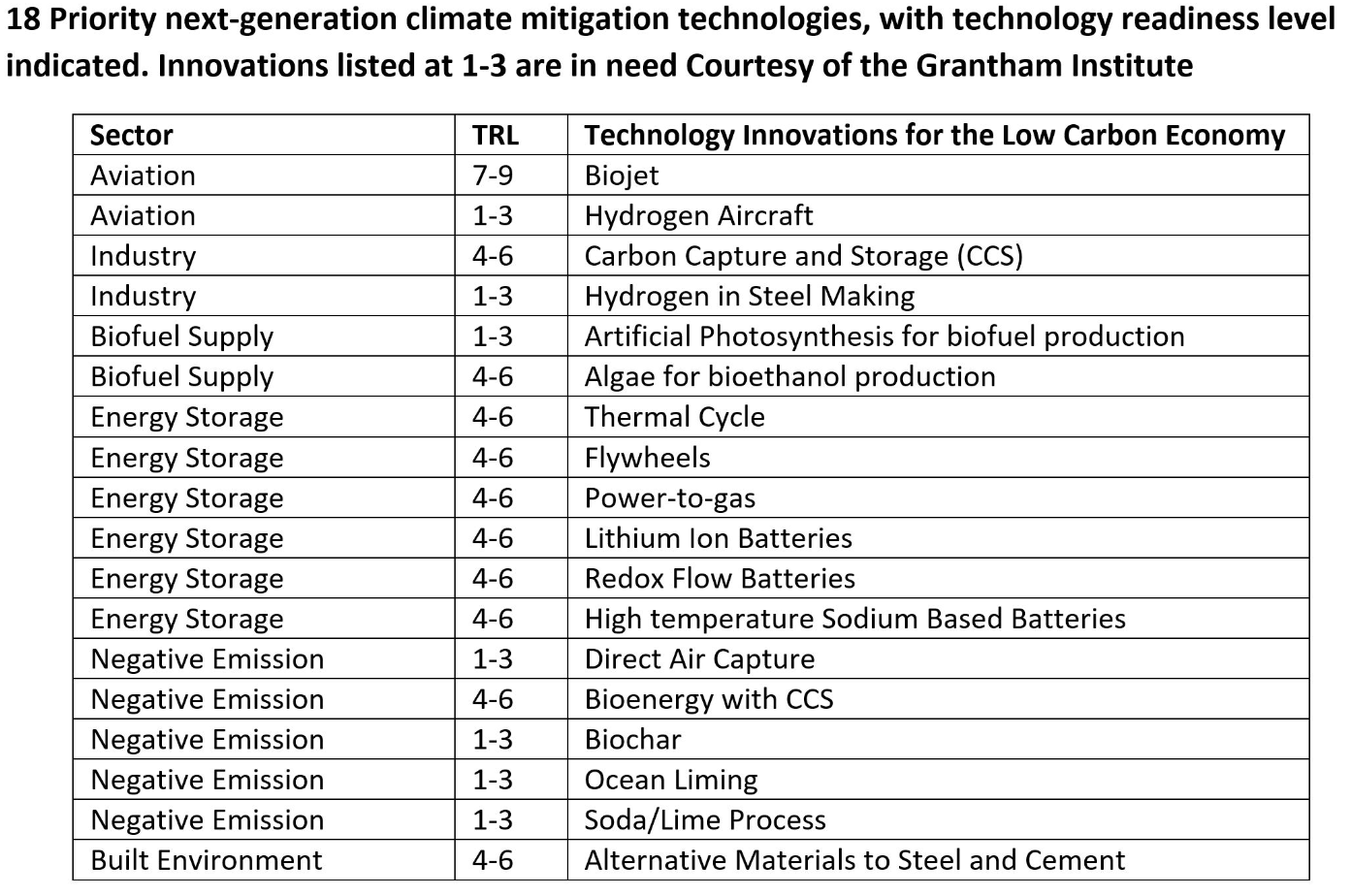18/07/2019
The Grantham Institute has released a report highlighting 18 priority technological innovations with significant potential to reduce greenhouse gas emissions. It makes interesting reading, although what is clear is urgent research and development in particular areas will be needed if we are to have a chance of avoiding a climate breakdown. The full report is attached here, with a summary pdf available for reference.
The Report
The innovations are categorised into 6 technology sectors, including 1) Aviation, 2) Built Environment, 3) Industry, 4) Energy Storage, 5) Biofuel supply, and 6) Negative Emission Technologies, and each given a technology readiness level TRL (a score between 1 and 9, indicating whether the innovation is at the stage of basic research (1-3), small scale technology development and trial (4-6), or large scale technological development and commercialisation (7-9).
Energy Storage and Aviation are two of the most well developed sectors. Biojet, a fuel primarily made from vegetable oils, such as Jatropha oil and recycled cooking oil, has been supplied at some airports since 2016 and can be used with existing airport refuelling infrastructure. Although, Biojet has the potential to reduce emissions from air travel, air travel is currently predicted to grow at around 5% a year, meaning that unless the number of flights is reduced, overall net emissions could still continue to rise. The report notes that if unchecked, emissions from aviation would rise from 750MtCO2 today to 3.1 GtCO2 by 2050. Hydrogen powered aircraft could be the answer, but are a still a long way from realisation.
Energy storage solutions for the energy grid, such as thermal cycle technologies, flywheels, and batteries, are well developed but have not yet been rolled out on a large scale. The report notes that for every 1 GW of intermittent renewable energy generation, 1 GW hour of storage capacity is needed. Increased deployment would therefore require an increase in extraction and utilisation of materials, meaning a need for associated innovations in clean material use and recapture. Techniques for carbon capture and storage are similarly well developed, but again need deploying at scale.
The next generation technology innovations most in need of development (presently indicated at the basic research level only) are negative emission technologies (technologies for rapidly drawing down CO2 from the atmosphere, involving techniques such as direct air capture, biochar and ocean liming), as well as efficient steel manufacturing techniques. These are discussed in more detail in the associated paper here.


By way of summary, the report notes that “for the mature technologies, early demonstration is now vital to show that commercialisation and roll out at scale is possible” and that while solar PV, heat networks and biomass should continue to be deployed, “investment in early stage new mitigation technologies will ensure that there are affordable options to help us reach net zero greenhouse emission in the long term”.
Policy and Market Considerations
Part of the challenge is the market, and a need for government policies to shape market investment. A report by LSE published as recently as 2016, for example, looked at activity in the EPO’s Y02 category in the Cooperative Patent Classification: “Technologies or Applications for Mitigation or Adaptation against Climate Change”, and noted that innovation in low carbon technologies had risen from the year 2000 but then fallen off drastically since 2013, largely correlating with the rise and subsequent collapse in the price of oil. Furthermore, as recently as May 2019, a group of eleven leading UK scientists published an open letter to philanthropists and grant bodies urging them to allocate more funding to climate change solutions.
Suitable public policies to stimulate innovation in low carbon technologies are largely absent at present. The UK Intellectual Property Office does offer the Green Channel, through which patent applicants can request accelerated examination for any technologies contributing towards environmental protection. However, most patent applicants are less concerned with the speed of examination than the actual costs of prosecution and enforcement.
An effective policy designed to stimulate innovations in these areas should therefore include monetary incentives, such as tax breaks and research and development grants. In the past decade, for example, China has been notable in offering state subsidies to companies filing patent applications, resulting in a huge increase in the number of patent applications filed, and one would hope, the associated innovation activities.
While patent office fees are only a part of the total costs of innovating and patenting, providing a reduction in patent office fees for innovations that mitigate against climate change would send a strong message of intent to society and to innovators. The US PTO Office for example currently offer a 50% reduction in official fees for Small and Medium Enterprises (enterprises having fewer than 500 employees) irrespective of the nature subject matter of their patent application. The IP5 patent offices, for example, could therefore offer a reduction to patent applications for technologies that directly aim to tackle the current climate crisis.
The UK Parliament has recently declared a Climate Emergency. If they are to honour this, now is the time to put effective measure in place to stimulate investment in technologies that reduce greenhouse gas emissions. To date, public policy has rewarded innovators for making creative contributions to society. Given the urgency of the present situation, we now require policy makers to be similarly creative.
This article is for general information only. Its content is not a statement of the law on any subject and does not constitute advice. Please contact Reddie & Grose LLP for advice before taking any action in reliance on it.


